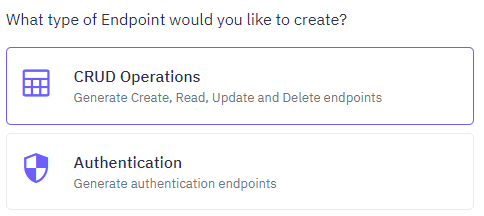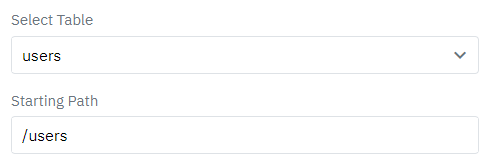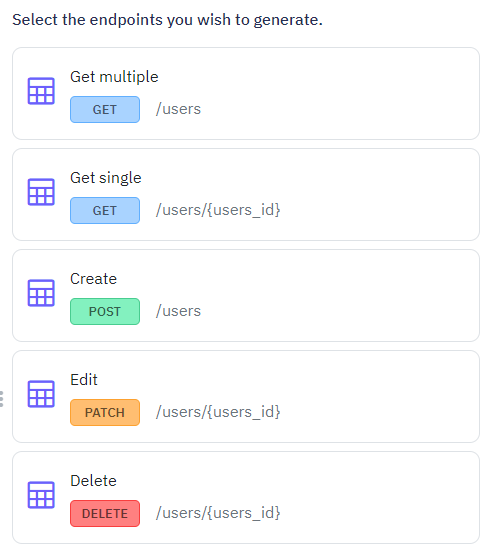CRUD stands for Create, Read, Update, Delete. These are the basic operations required to manage data in a database. Each operation corresponds to a specific HTTP method:
Create: Adds new data (HTTP POST)
Read: Retrieves data (HTTP GET)
Update: Modifies existing data (HTTP PATCH)
Delete: Removes data (HTTP DELETE)
By generating CRUD endpoints, you automate the process of creating these operations for your database tables, simplifying backend configuration and enabling seamless data management.
-
With Twidget, once you have a table created, you can easily generate CRUD endpoints to manage the data within that table. The platform will automatically generate the relevant inputs, commands, steps, database queries, and outputs.
Navigate to the API Page
Create Endpoints
Click the Create Endpoints button located at the top right corner of the page.
A new sidebar will open to guide you through the endpoint creation process.

CRUD Operations

Select Database Table
Define Path
/users if dealing with a users table).
Get: Retrieve a list of records from the table.
Get Single: Retrieve a single record by its identifier.
Create: Add a new record to the table.
Edit: Update an existing record.
Delete: Remove a record from the table.

After generating the endpoints, you can edit the commands and configurations as needed. This allows more control over the behavior of each endpoint, enabling customization to meet specific requirements.
By following these steps, Twidget makes it easy to set up comprehensive data management operations on your platform, reducing the complexity and time required to manage backend systems.
Endpoint Basics
An endpoint refers to a specific URL (Uniform Resource Locator) that a client can access to interact with the API and perform various operations. Endpoints act as gateways that allow clients (such as web or mobile applications) to communicate with the server hosting the API and perform actions like ...
API Settings
The API settings in Twidget enable you to customize your APIs to fit your requirements. Here’s how you can do it: Configure. 1. Navigate to the API page. 2. Click on the Settings button located at the top-right corner. This will open a sidebar where you can configure various settings for your API. A...
What is an API
An API (Application Programming Interface) is a set of rules and protocols that allows different software applications to communicate and interact with each other. It defines the methods and data formats that applications can use to request and exchange information, services, or functionalities from...
Authentication
Twidget supports Bearer Authentication to ensure secure access to your endpoints. You can specify which endpoints should be secured or open. Once secured, an endpoint can only be accessed using a valid Bearer Token, which is generated via our API. Additionally, we provide functionality to generate a...
Endpoint Inputs
In Twidget, endpoints have a variety of input types that can be used to configure and execute API requests. These input types include queries, headers, body, files, and path inputs. Each input type serves a specific purpose in allowing users to interact with APIs efficiently. Files. The files input ...